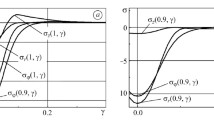Abstract
This paper gives an interpretation of the layers of elastic potentials, which are used to solve elastic boundary value problems of bodies and plates (extensional case). The layers appear as physical quantities on the boundary of the complement of the original body. The insight into the physical nature of the layers allows qualitative estimates to be made for the layers near critical points on the boundary of the body or plate.
Zusammenfassung
Der Aufsatz gibt eine physikalische Interpretation der Belegungen elastischer Potentiale, wie sie zur Lösung elastischer Randwertprobleme benutzt werden. Die Belegungen erscheinen als physikalische Größen auf dem Rand des Komplements des ursprünglichen Körpers. Die Einsicht in die physikalische Natur der Belegungen gestattet qualitative Abschätzungen für die Belegungen nahe kritischen Punkten auf dem Rand des Körpers oder der Platte.
Similar content being viewed by others
Explore related subjects
Discover the latest articles and news from researchers in related subjects, suggested using machine learning.References
Kupradze V. D., ed., Three Dimensional Problems of the Mathematical Theory of Elasticity and Thermoelasticity. North-Holland Publishing Co., Amsterdam 1979.
Rizzo F. J., An integral equation approach to boundary value problems of classical elastostatics. Quart. App. Math. 25 (1967) 83–95.
Kupradze V. D. Potential Methods in the Theory of Elasticity. Israel Program for Scientific Translation, Jerusalem 1965.
Author information
Authors and Affiliations
Rights and permissions
About this article
Cite this article
Hartmann, F. The physical nature of elastic layers. J Elasticity 12, 19–29 (1982). https://doi.org/10.1007/BF00043703
Received:
Revised:
Issue Date:
DOI: https://doi.org/10.1007/BF00043703



